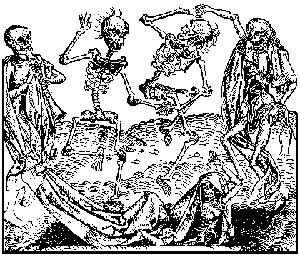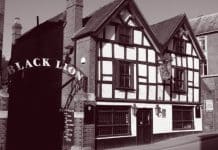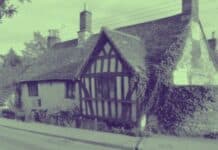JON KANEKO-JAMES uncovers the grotesque monsters of Walter Map’s medieval Britain

History wasn’t always as safe as it was meant to be. Whereas now to find scary history you have to come here to The Spooky Isles, in 12th century Britain waiting to jump out and convince you that there were horrible monsters lurking behind every corner.
Respected historians like Geoffrey of Monmouthshire collected tales that claimed Britain was named after a Roman called Brutus who came here and did a WWE/BFG crossover by getting his friend Corineas to wrestle all the giants to death (except two, who stayed alive and fought for him, and who are believed to be buried somewhere under London… although this is more likely to be a confused urban myth than real folklore, the confused memories of effigies used in the Lord Mayor’s Parade.)
Other historians, like William of Newburgh were frostier and kept to the facts – ordinary things like stories of dancing corpses, and an abusive husband who comes back from the grave to crawl back into bed with his wife.
Amongst all of this was the work Walter Map: a satirist, historian and priest who prided himself on being a parodic social commentator 700 years before Oscar Wilde got a look in. Map was born in Herefordshire in 1140, knew the famous ‘turbulent priest’ Thomas Becket and travelled Europe collecting tall tales to tell his public. After he died a book of his best tall tales (and biting wit) was released called De Nugis Curialium, or ‘The Trifles of the Courtiers.’
But make no mistake, this isn’t just Perez Hilton or Sex in the City. Horror was his business.
Map, suspected of being secretly Welsh by some historians, supplements the gossip and satire with stories of the sorts of horrible monsters that readers can be expected to meet in their everyday lives.
In one of his stories, Walter Map describes a Knight from Herefordshire called William Laudun who came to the bishop’s court with a particularly macabre problem:
“Lord, I take refuge with you seeking advice. A certain evil Welshman quite recently died irreligiously in my village, and immediately after four nights he took to walking back to the village each night, and will not stop calling out by name each of his neighbours. As soon as they are called, they take ill, and withing three days they die, so that already very few are left.”
Medieval Suicide and Sinners
Walter Map talks about how suicides and sinners need to be buried at the crossroads, or else beheaded and doused in holy water (the eventual fate of the ‘certain evil Welshman’), to avoid them returning after death to harass and slowly drain the life out of their former friends and relatives.
He tells of the Dance of the Dead, with the living being ensnared into an eternal hellish dance by the faeries (medieval faeries were occupied a strange place half way between the living and the dead), dancing hand in hand with rotting corpses until they were rescued.
Some, like the wife of a knight Map writes about, might even have their souls harvested after death and be forced to dance with the dead until they’re rescued by a loved one.
Finally, Map’s world is a world where all it takes is a moment of temptation to meet the devil at the crossroads. He tells the story of the boy Eudo, the son of a young knight who has lost everything: his father’s money and lands, who meets the devil at the moment of his deepest despair. The boy is given three magical amulets that will grant him Satanic powers to gather money and kill without consequence, and is quickly seduced into a life of murder, debauchery and theft. The devil tells him that all the spirits of the old myths, everything from faeries to the dryads of Ancient Greece, are demons, waiting out in the wild places.
And those wild places are wild: should you venture out there, don’t go near the water. Not only might you find faerie women dancing naked in the moonlight (this might sound good, but we’re in the world of medieval history/folklore so this is never good) but you might even find King Herla, the original King Arthur, leading his wild hunt of undead knights galloping into the river Wye: part of a curse he earned for offering poor hospitality to the King of the Dwarves.
One edition of Walter Map’s De Nugis Curialium has a side-by-side translation into English. Please go to your local library and ask for the 1983 edition from Oxford Clarendon Press, edited by CNL Brooks and RAB Mynors. It’s a fantastic look into the macabre, demon-haunted world of medieval England.







